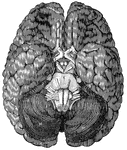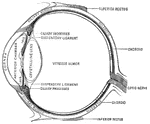Clipart tagged: ‘optic’
Micrographic Apparatus with Camera and Microscope
An apparatus used to photograph images in a light microscope. The long camera is connected to the eye…
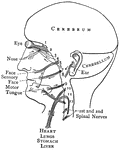
Distribution of the Cranial Nerves
"The cranial nerves are thus arranged in pairs: 1, olfactory nerves, special nerves of smell; 2, optic…
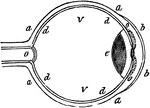
Eye
"a, sclerotic membrane; b, cornea; d, retina; o, optic nerve; v, vitreous humor." -Comstock 1850

Eye Muscles
"The external bones of the temple are supposed to be removed in order to render visible the muscular…

Diagram of the Eye
"Diagram illustrating the Manner in which the Image of an Object is inverted on the Retina." — Blaisedell,…
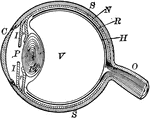
Eyeball
"The most essential parts of human vision are contained in the eyeball, a nearly spherical body, about…
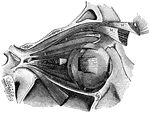
Muscles of the eyeball
"A, attachment of tendon connected with the four recti muscles; B, external rectus,…

Muscles of the Eyes
"The eye is moved about by six muscles. The back ends of these muscles are attached to the eye sockets.…
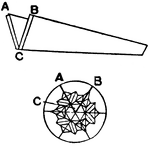
Mirrors in a Kaleidoscope
This illustration shows the arrangement of mirrors in a kaleidoscope (AC and BC), and the patterns formed.

Optical Lantern
"The optical lantern is an instrument for projecting on a screen magnified images of transparent photographs,…

Huyegenian Eyepiece Diagram Showing Lens Refraction
"They have also a shorter focus for red, and a longer one for blue, and thus magnify the red image more…

Ramsden Eyepiece Lens Refraction Diagram
"If the real image produced by the objective coincides with the collective lens, only the inclination…
Light Correction of Blue and Red Lights using Spherical Lens
"Showing a system with chromatic difference of spherical aberration. O" ₌ image of O for red light;…

Microscope
"A microscope consists of a lens or a combination of lenses used to observe small objects, often so…

Baker Demonstration Light Microscope with Mirror Reflecting Light Source
A Baker demonstration light microscope illustrating the different parts of the microscope. The eyepiece…

Swift Stephen's Binocular Microscope with Mirror Reflecting Light Source
A swift Stephenson's Binocular Microscope with a mirror reflecting light source. The microscope has…
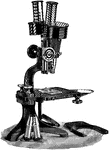
Greenough's Binocular Light Compound Microscope with Mirror Reflecting Light Source
A Greenough's binocular light microscope. The microscope has two eyepieces to view the sample with both…

Leitz Micrometer Adjustment Screw for Microscope
An adjustment screw diagram used to raise or lower microscope slightly. The series of screw and springs…

Petrographical Light Microscope with Mirror and Eyepieces
A petrographic light microscope used to identify thin layered rocks and minerals. The microscope have…
Swift and Son Micrometer Adjustment Lever for Microscope
"The long lever D is pressed to one side by the screw F, and is thus turned round the in E. On the tube…

Microscope Mirror Illumination by Light Reflection
A light reflection diagram of a light microscope using a mirror. The mirror is used in a microscope…

Abbe Microscope Mirror Illumination by Light Reflection with Condenser
Illustration showing Abbe illuminating apparatus with condenser. The mirror, m, reflects light from…

Perch Brain
"Brain of Perch. Upper aspect. a, cereoellum; b, optic lobes; c, hemispheres; e, lobi inferiores; f,…

Perch Brain
"Brain of Perch. Lower aspect. a, cereoellum; b, optic lobes; c, hemispheres; e, lobi inferiores; f,…

Retina
"Diagram illustrating the points at which incident rays meet the retina. xx, optic axis; k, first nodal…
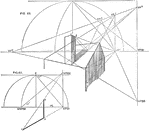
Shadow of a Perpendicular Object
"To show how a shadow if a perpendicular object is to be projected on an inclined plane." -Benson, 1891

Virtual Image Formed on Spherical Surface
"O' is the virtual image of O formed at a spherical surface of centre C and radius CS." —Encyclopaedia…

Large Dissecting Stand with Magnification Eyepiece Mirror Reflecting Light Source
A large dissecting stand with magnification eyepiece and mirror reflecting the light source. The stand…
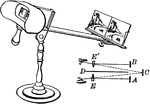
Stereoscope
"The stereoscope is an instrument for illustrating the phenomena of binocular vision, and for producing…
Galilean Telescope
"The Galilean telescope has a double-concave eye-lens that intercepts the rays before they reach the…
Terrestrial Telescope
"The spy-glass or terrestrial telescope avoids the inversion of the image by the interposition of two…
